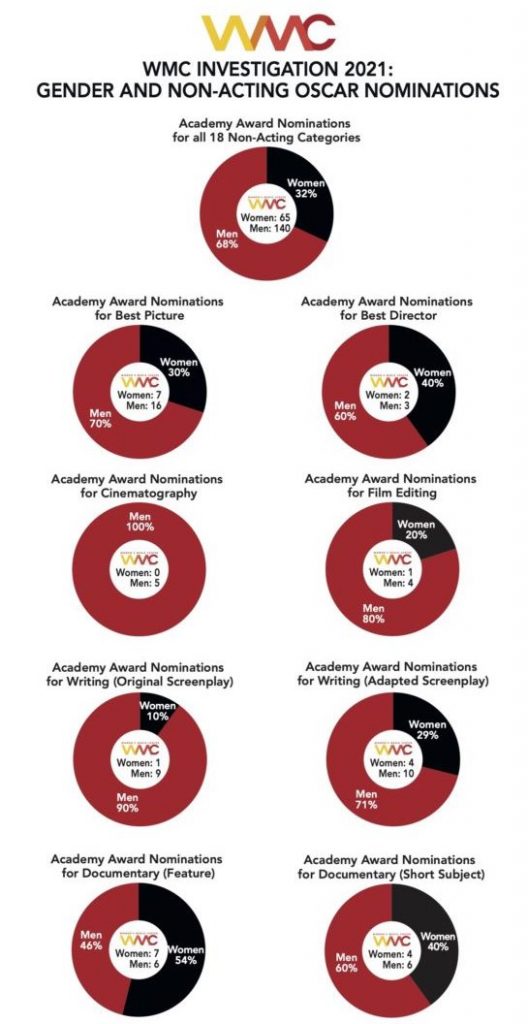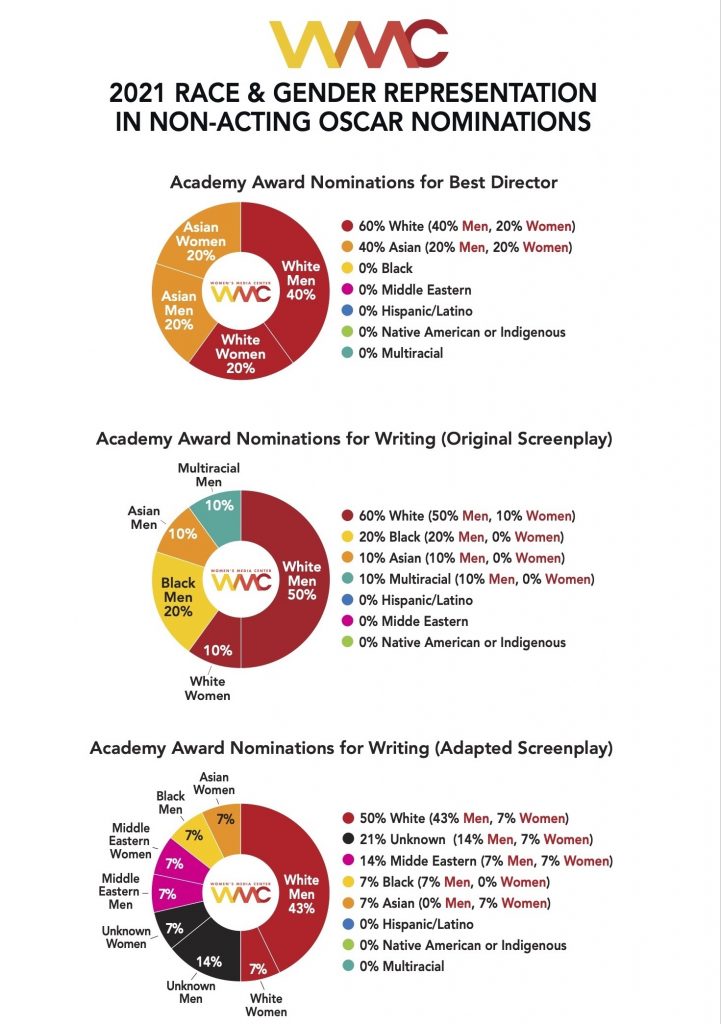“How can we possibly understand the perspectives, concerns, experiences and lives of over half the population if women are not allowed to be half of the storytellers?”
—Julie Burton, president and CEO of the Women’s Media Center

As the 2021 Oscars ceremony on Sunday, April 25, celebrated a year of film unlike any other, a recent report from the Women’s Media Center sheds light on progress as well as continued gender disparities in non-acting nominations. In total, the report shares, only 32 percent of the 205 total non-acting nominations—for critical roles such as writing, editing, directing and producing—included women, a two percentage point increase from the year prior.
“This new analysis shows that the nomination numbers for women behind the scenes have barely inched up by two percentage points since last year, and that feels discouraging,” said Julie Burton, president and CEO of the Women’s Media Center. Still, there has been progress over the long arc of the Academy of Motion Picture Arts and Sciences’ history; just 10 years ago, only 21 percent of the non-acting nominations went to women.
Much of this progress has been concentrated within the highest profile nominations, such as in the “Best Picture” category. Seven of this year’s 23 total nominees for the category were women, chosen for their roles in producing the films Minari, Nomadland and Promising Young Woman. Three of these women were recognized when Nomadland was announced as the winner. Producers Chloé Zhao and Frances McDormand took the stage, with McDormand asking the audiences on- and off-screen to watch their film “on the largest screen possible.”
This year’s “Best Director” category presented a historic cast of nominees as well—distancing itself from the controversies of years past. In 2020, the Academy drew ire from activists as well as the general public for its failure to include women nominees in the “Best Director” category, despite Greta Gerwig’s emergence as a strong contender after her big-screen adaptation of Little Women. Prior to this year, the Academy had only ever wreathed one woman with this award in its history—Kathryn Bigelow in 2010 for The Hurt Locker—and had since only nominated one other woman for the honor.
In a departure from this history, this year the Oscars included among its “Best Director” nominations Chloé Zhao for Nomadland and Emerald Fennell for Promising Young Woman. Both of these nominees’ movies center female narratives, with Nomadland following an itinerant woman who embarks on a journey across the American West after losing almost everything to the Great Recession; and Promising Young Woman spinning a clever revenge plot after a devastating sexual assault, a story bearing the watermark of the #metoo movement.
The Academy continued this history-making trajectory the night of the Oscars by awarding the title of “Best Director” to Chloé Zhao, the first woman of color to win in that category. Zhao invoked her Chinese heritage in her acceptance speech, referencing a line in a classic Chinese text that has fueled her throughout the journey of directing films: “People at birth are inherently good.” Her pioneering win has been lauded by celebrities, activists, scholars and those watching from all corners of the United States and the world.

Disruptions to the Film Industry Make Space for Women
“This year’s history-making representation of women in that category is in part due to the activism of many groups that agitated last year and because of the longer term work we and many others have engaged in to document the lack of equality in the industry and call for change,” said Burton.
Another element working in the background of this progress is the disruption endured by the film industry this past year due to the COVID-19 pandemic. As big-budget films pushed their release calendars to after 2020, a smaller pool of contenders remained. “The benefit of having so many major studio releases out of the race was that the spotlight could shine on films that might not have had the opportunity otherwise—including films whose directors are women,” Burton told Ms.
“Most Women of Color Are Kept Waiting at the Door”: Awards Categories Continue to Shirk Women, Especially Women of Color
However, while high-profile categories such as “Best Director” and “Best Picture” saw progress, categories celebrating those behind the curtains have been especially slow to embrace more representation of women. In particular, the “Cinematography” and “Music (Original Score)” categories this year included no women among its pool of nominees. Only three women have been nominated in either category over the span of the past decade.
While many of these behind-the-scenes roles do not receive the same interest and attention as directors, they still remain crucial to the success of any film. As Burton shared, the lack of representation in these corners of the film industry is just as consequential as a lack of representation in the director’s chair.
“How can we possibly understand the perspectives, concerns, experiences and lives of over half the population if women are not allowed to be half of the storytellers?” Burton said. “When 73 percent of the writers are doing so from a male perspective, that is a problem. When 94 percent of the cinematographers are framing the picture from a male perspective, that is a problem. When 72 percent of the editors decide what matters from a male perspective, that is a problem.”
The lack of representation is especially acute for women of color. No women of color were nominated for the “Writing (Original Screenplay)” category—though the category broke boundaries in other respects by including three Black and one Asian American nominee. Women of color also represent 14 percent of the “Writing (Adapted Screenplay)” nominees.
The Oscars did present a win in non-acting nominations for women of color in the “Makeup and Hairstyling” category, which recognized Sergio Lopez-Rivera, Mia Neal and Jamika Wilson for their work styling the characters in Ma Rainey’s Black Bottom. “I also stand here as Jamika and I break this glass ceiling with so much excitement for the future,” said Neal at the microphone, “because I can picture Black trans women standing up here and Asian sisters and our Latino sisters and Indigenous women. And I know that one day it won’t be unusual or groundbreaking; it will just be normal.”

In order to make “normal” a possibility, Burton emphasized the need to open up doors in the industry to those who have historically seen them closed. “Women of color need equal opportunity to shine in every level of the film industry. If a Chloé Zhao cannot get her foot through the door, she cannot be nominated for her artistry and excellence,” Burton said. “The good news is this year Chloé Zhao made history, but the bad news is that most women of color are kept waiting at the door. Imagine what great, impactful stories the world would hear if the industry opened up those doors.”
As the Academy comes off of a historic awards ceremony, the WMC report serves as a reminder that there is still progress to be made to include the voices that have historically been relegated to the margins of the film industry. At stake is the ability of this industry to speak to an increasingly diverse audience of movie-goers.
“These images and stories, largely from a male perspective, shape the culture by telling us who we are, what our roles in society are, and what we can be,” Burton said. “Media frames our democratic debate, interprets and amplifies our policies and our politics. Media tells us who has power and who matters. And in so much of our film industry, because women and people of color are not given equal roles in front of and behind the camera, their valuable life experiences, perspectives, and impact are missing.”
Up next:





